Younes Bouhadjar
NeuroBench: Advancing Neuromorphic Computing through Collaborative, Fair and Representative Benchmarking
Apr 15, 2023



Abstract:The field of neuromorphic computing holds great promise in terms of advancing computing efficiency and capabilities by following brain-inspired principles. However, the rich diversity of techniques employed in neuromorphic research has resulted in a lack of clear standards for benchmarking, hindering effective evaluation of the advantages and strengths of neuromorphic methods compared to traditional deep-learning-based methods. This paper presents a collaborative effort, bringing together members from academia and the industry, to define benchmarks for neuromorphic computing: NeuroBench. The goals of NeuroBench are to be a collaborative, fair, and representative benchmark suite developed by the community, for the community. In this paper, we discuss the challenges associated with benchmarking neuromorphic solutions, and outline the key features of NeuroBench. We believe that NeuroBench will be a significant step towards defining standards that can unify the goals of neuromorphic computing and drive its technological progress. Please visit neurobench.ai for the latest updates on the benchmark tasks and metrics.
Skip Connections in Spiking Neural Networks: An Analysis of Their Effect on Network Training
Mar 23, 2023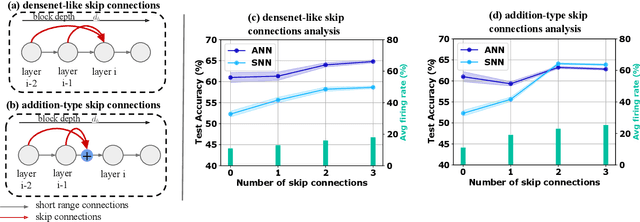

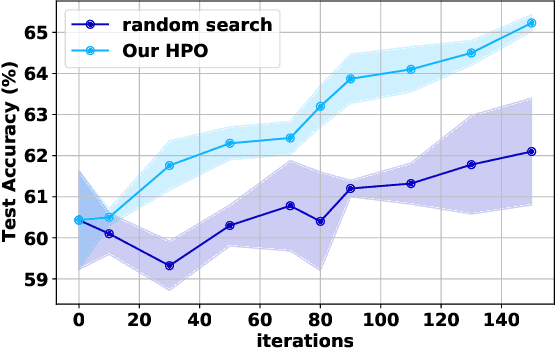

Abstract:Spiking neural networks (SNNs) have gained attention as a promising alternative to traditional artificial neural networks (ANNs) due to their potential for energy efficiency and their ability to model spiking behavior in biological systems. However, the training of SNNs is still a challenging problem, and new techniques are needed to improve their performance. In this paper, we study the impact of skip connections on SNNs and propose a hyperparameter optimization technique that adapts models from ANN to SNN. We demonstrate that optimizing the position, type, and number of skip connections can significantly improve the accuracy and efficiency of SNNs by enabling faster convergence and increasing information flow through the network. Our results show an average +8% accuracy increase on CIFAR-10-DVS and DVS128 Gesture datasets adaptation of multiple state-of-the-art models.
Sequence learning in a spiking neuronal network with memristive synapses
Nov 29, 2022Abstract:Brain-inspired computing proposes a set of algorithmic principles that hold promise for advancing artificial intelligence. They endow systems with self learning capabilities, efficient energy usage, and high storage capacity. A core concept that lies at the heart of brain computation is sequence learning and prediction. This form of computation is essential for almost all our daily tasks such as movement generation, perception, and language. Understanding how the brain performs such a computation is not only important to advance neuroscience but also to pave the way to new technological brain-inspired applications. A previously developed spiking neural network implementation of sequence prediction and recall learns complex, high-order sequences in an unsupervised manner by local, biologically inspired plasticity rules. An emerging type of hardware that holds promise for efficiently running this type of algorithm is neuromorphic hardware. It emulates the way the brain processes information and maps neurons and synapses directly into a physical substrate. Memristive devices have been identified as potential synaptic elements in neuromorphic hardware. In particular, redox-induced resistive random access memories (ReRAM) devices stand out at many aspects. They permit scalability, are energy efficient and fast, and can implement biological plasticity rules. In this work, we study the feasibility of using ReRAM devices as a replacement of the biological synapses in the sequence learning model. We implement and simulate the model including the ReRAM plasticity using the neural simulator NEST. We investigate the effect of different device properties on the performance characteristics of the sequence learning model, and demonstrate resilience with respect to different on-off ratios, conductance resolutions, device variability, and synaptic failure.
On transfer learning using a MAC model variant
Nov 16, 2018


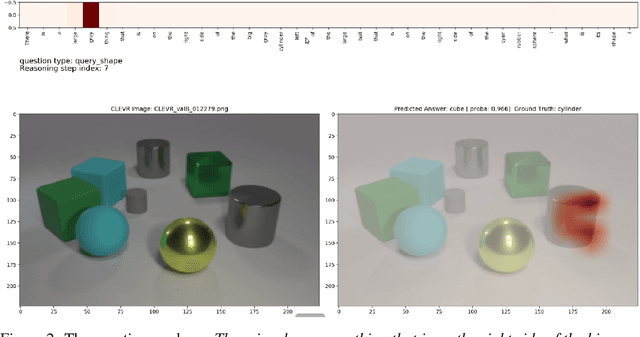
Abstract:We introduce a variant of the MAC model (Hudson and Manning, ICLR 2018) with a simplified set of equations that achieves comparable accuracy, while training faster. We evaluate both models on CLEVR and CoGenT, and show that, transfer learning with fine-tuning results in a 15 point increase in accuracy, matching the state of the art. Finally, in contrast, we demonstrate that improper fine-tuning can actually reduce a model's accuracy as well.
Learning to Remember, Forget and Ignore using Attention Control in Memory
Sep 28, 2018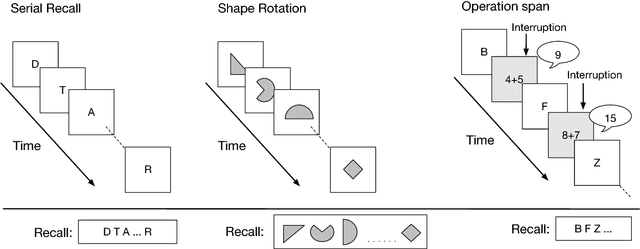
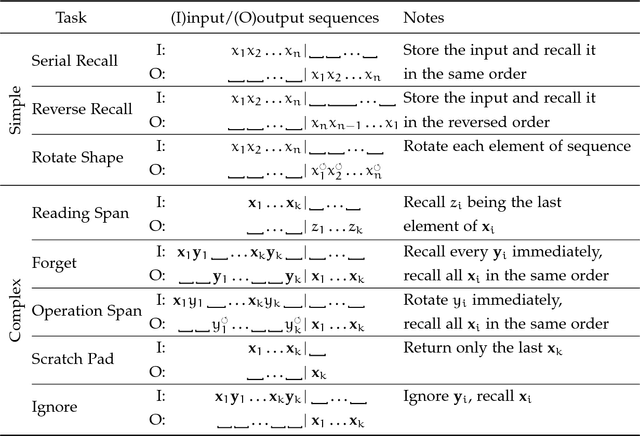

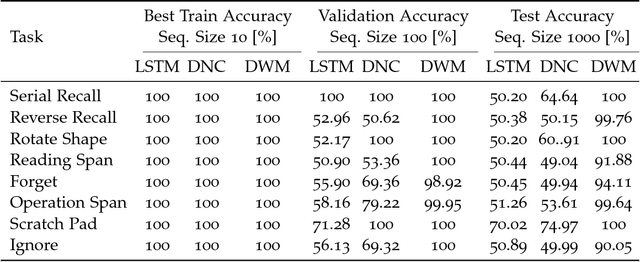
Abstract:Typical neural networks with external memory do not effectively separate capacity for episodic and working memory as is required for reasoning in humans. Applying knowledge gained from psychological studies, we designed a new model called Differentiable Working Memory (DWM) in order to specifically emulate human working memory. As it shows the same functional characteristics as working memory, it robustly learns psychology inspired tasks and converges faster than comparable state-of-the-art models. Moreover, the DWM model successfully generalizes to sequences two orders of magnitude longer than the ones used in training. Our in-depth analysis shows that the behavior of DWM is interpretable and that it learns to have fine control over memory, allowing it to retain, ignore or forget information based on its relevance.
 Add to Chrome
Add to Chrome Add to Firefox
Add to Firefox Add to Edge
Add to Edge